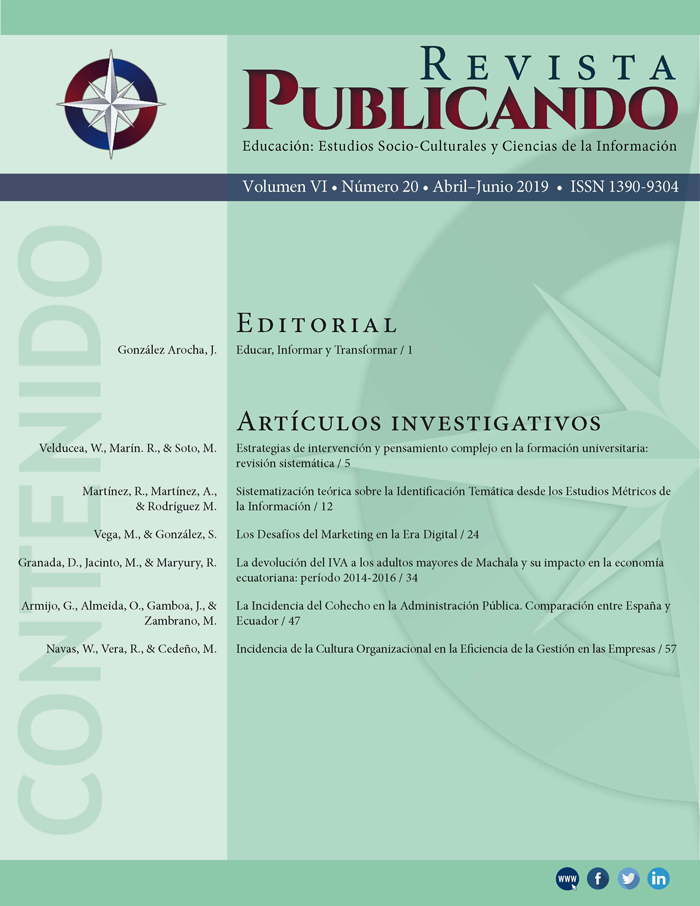Abstract
This article aims at experimental development on the different parameters that involve DC machines, their operation and those variables that we must consider when choosing a machine with these characteristics, in addition to the possible solutions and aspects that this implies before a possible utility of this type of machine. The objective is to determine the characteristics of the torque based on speed and efficiency. The methodology used was experimental in which it was determined that the speed of any direct current (c-d) motor depends mainly on its armature voltage and the intensity of the magnetic field. A shunt motor, field winding, and armature winding are connected in parallel directly to the direct current (dc) power lines if the direct current line voltage (dc) is constant, the armature voltage and Field strength will be constant too. Therefore, the parallel motor must run at a reasonably constant speed. However, the store speed will decrease when the engine load is increased. The material used to carry out this research was a 120 Vac module, 0-120 Vdc, cd motor/generator module, electrodynamometer, cd measurement modules (200v, 5 A), digital tachometer. Finally, we can indicate that the characteristic of a motor (cd) is that they are more effective to perform jobs that require a constant speed both empty and full load and their efficiency reaches a maximum value of 60% then tends to decrease.
References
JOSí‰ ROLDíN VILORIA, Motores de corriente continua, Ediciones Paraninfo, S.A., 2014.
A. Senner, Principios de electrotecnia, Reverte,, 1992.
Guzmán Díaz González, Arsenio Barbón ílvarez, Javier Gómez-Aleixandre Fernández, Variación de la velocidad de los motores eléctricos, Universidad de Oviedo, 2002 .
Theodore Wildi, Maquinas Electricas Y Sistemasde Potencia.
R. C. G. C. R. J. V. A. D. M. D. S. A. Editorial Mad, Psicólogo de la Xunta de Galicia, MAD-Eduforma, 2006.
Juan Carlos Martín, M ª Pilar García, Motores eléctricos (Automatismos industriales), Editex, 2016.
P. Bastian, Electrotecnia, E. AKAL, Ed., 2001.
R. G. Seippel, Fundamentos de electricidad: principios de electricidad, electr ¢nica, control y ordenadores, reimpresa ed., Reverte, Ed., 1977.
Arce Amador Ismael, Hernández Torres Juan Rafael, García Huerta Gerardo, Martinez Romero Gabriel Dante, Primo López Carlos Alberto, Ramirez Valadez Edgar., «Motor DC Shunt o conexión en paralelo, » Equipo de estudiantes de ingeniería Eléctrica del Instituto Tecnológico de Puebla., 2015.
J. perez, 2014. [En línea]. Available: https://prezi.com/_0boutjrtrkx/motores-shunt/.
j. a. mero, «Tipos de motores de corriente continua, » 2005. [En línea]. Available: https://iesvillalbahervastecnologia.files.wordpress.com/2010/02/motores-electricos-parte-ii1.pdf.
T. Wildi, Maquinas electricas y sistemas de potencia, 2007.
R. C. Hibbeler, Mecánica vectorial para ingenieros: estática, Pearson Educación, 2004.
V. F. Veley, AC/CD Electricity and electronics, 1990.
F. a. Higginbotham, Basic Electrical engineering International Student, 1957.
You are free to:
Share — copy and redistribute the material in any medium or format.
Adapt — remix, transform, and build upon the material.
The licensor cannot revoke these freedoms as long as you follow the license terms.
Under the following terms:
Attribution — You must give appropriate credit, provide a link to the license, and indicate if changes were made. You may do so in any reasonable manner, but not in any way that suggests the licensor endorses you or your use.
NonCommercial — You may not use the material for commercial purposes.
ShareAlike — If you remix, transform, or build upon the material, you must distribute your contributions under the same license as the original.
No additional restrictions — You may not apply legal terms or technological measures that legally restrict others from doing anything the license permits.
